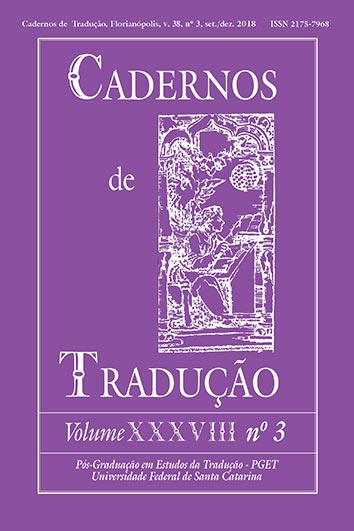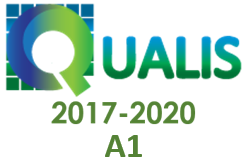ESP and the shared expertise: convergences with translation and terminology
DOI:
https://doi.org/10.5007/2175-7968.2018v38n3p399Abstract
This paper critically addresses aspects related to the teaching of the English language in specialized texts in the scope of English for Specific Purposes. It problematizes this approach within the context of language courses – focusing on the reading competence – EAP modality (STREVENS, 1977; HYLAND, 2006). It establishes theoretical convergences with the fields of Translation and Terminology. The perspective adopted aims to contribute to the development of the agents involved and to the improvement of pedagogical practice, broadening new paths and theoretical-methodological possibilities. The motivation for this study emerges from the growing and expressive pursuit of reading competence enhancement in texts with scientific content in foreign languages by professionals and academics from different domains. This demand is characterized by well-defined professional targets associated to mechanisms of acceleration of results stemming from the exogenous pressure for qualification. It is intended to describe the peculiarities of the teaching context where these reflections emerge from and connect them to some methodological procedures employed in solving textual exploratory difficulties supported by translation strategies and terminological knowledge.References
ASKEHAVE, Inger; SWALES, John. M. Genre identification and communicative purpose: A problem and possible solution. Applied Linguistics, [S.L] v. 2 n.22, p. 195-212, 2001.
BACHMAN, Lyle. Fundamental Considerations in language Testing, Oxford: Oxford University Press,1990.
BELCHER, Diane. English for specific purposes: Teaching to perceived needs and imagined futures in worlds of work, study, and everyday life. TESOL Quarterly, [S.L] 40, 133-156, 2006.
_________. What ESP is and can be: An introduction. In: ______ (Ed.), English for specific purposes in theory and practice. p. 1-20. Ann Arbor: University of Michigan Press, 2009.
BELL, Timothy. Extensive Reading: Why? And How?. Internet TESL Journal, [S.L], v. IV, n. 12, Dec. 1998. Disponível em http://iteslj.org/Articles/Bell-Reading.html acesso em 08 de outubro 2017.
BHATIA, Vijay Kumar. Analysing genre: Language use in professional settings. London: Longman, 1993.
BIDERMAN, Maria Teresa Camargo. O conhecimento, a terminologia e o dicionário, Cienc. Cult. São Paulo, v.58 n.2 Apr./June 2006. Disponível em: http://cienciaecultura.bvs.br/pdf/cic/v58n2/a14v58n2.pdf. Acesso em 01/10/2017.
BRASIL. Secretaria de Educação Fundamental. Parâmetros curriculares nacionais: terceiro e quarto ciclos do ensino fundamental. Língua portuguesa. Brasília: MEC/SEF, 1998.
BOTTA, Mariana Giacomini. Comportamento dos termos do meio ambiente em textos de vulgarização. TradTerm, São Paulo, v. 22, Dezembro/2013, p. 191-216
CANALE, Michael. From communicative competence to communicative language pedagogy. In: RICHARDS, J.C.; SCHMIDT, R.W. (Eds.) Language and Communication, Londres: Longman. 1983.
______; SWAIN, M. 1980. Theoretical Bases of Communicative Approaches to Second Language teaching and testing. Applied Linguistics, [S.L], v.1, 1980.
DeAQUINO, Carlos Tasso Eira. Como Aprender: andragogia e as habilidades de aprendizagem. São Paulo: Pearson, 1ª ed., 2007.
DUDLEY- EVANS, Tony & St. JOHN, Maggie Jo. Developments in English for specific purposes: A multi-disciplinary approach. Cambridge, UK: Cambridge University Press, 1998.
ECO, Umberto. Quase a Mesma Coisa. Tradução de Eliana Aguiar. São Paulo: Record, 2007.
FAULSTICH, Enilde Leite de Jesus; ABREU, Sabrina Pereira. Linguística aplicada à Terminologia e à Lexicografia. Porto Alegre: UFRGS, 2003.
GAVIOLI, Laura. Exploring corpora for ESP learning. Amsterdam: John Benjamins, 2005.
HAMP-LYONS, Liz. English for Academic Purposes. In: CARTER, Ronald; NUNAN, David (Eds.), The Cambridge guide to Teaching English to Speakers of Other Languages Cambridge: Cambridge University Press, p. 126-130, 2001.
HASAN, Ruqaiya. What’s going on: a dynamic view of context in language. In: BUTT, David; CLORAN, Carmel; WILLIAM, Lycan, (Eds.) Ways of Saying: Ways of Meaning. London: Cassel, p. 37-50, 1996b.
HENSCHKE, John. Perspectives on International Adult Education. Adult Learning, [S.L], v. 16, n. 1;2, 2008.
HURTADO-ALBIR, Amparo. La traducción en la enseñanza comunicativa” In: Cable: revista de didáctica del español como lengua extranjera, Madrid, p. 42-45 1988a.
HUTCHINSON, Tom & WATERS, Alan. English for specific purposes: A learning-centred approach. Cambridge, UK: Cambridge University Press, 1987.
HYLAND, K. Specificity revisited: How far should we go now?. English for Specific Purposes, [S.L], v. 21, n. 4, p. 385–395, 2002.
______. Genre and second language writing. Ann Arbor: University of Michigan Press, 2004.
______. English for academic purposes: An advanced resource book. London: Routledge, 2006.
HYMES, Dell Hathaway. Two types of Linguistic Relativity. In: BRIGHT, William Sociolinguistics. The Hague: Movton, p.114-158, 1966.
______. Acerca de la Competencia Comunicativa. In: LLOBERA, Miquel. et al. Competencia comunicativa. Documentos básicos en la enseñanza de lenguas extranjeras. Madrid: Edelsa, 1995.
______. On Communicative Competence, Philadelphia: University of Pennsylvania Press, 1971.
JOHNS, Ann.; DUDLEY-EVANS, Tony. English for specific purposes: International in scope, specific in purpose. TESOL Quarterly, [S.L], 25, p. 297-314, 1991.
KIRALY, Donald. A Social Constructivist Approach to Translator Education; Empowerment from Theory to Practice, London;New York: Routledge, 2000.
KNOWLES, Malcolm Shepherd. The modern practice of adult education: From pedagogy to andragogy. Englewood Cliffs: Prentice Hall –Cambridge, 1980.
PACTE. Building a translation competence model. In: ALVES, Fabio. (Ed.). Triangulating Translation: Perspectives in process oriented research. Amsterdam /Philadelphia: John Benjamins, p. 43-66, 2003.
______. Investigating Translation Competence: Conceptual and Methodological Issues. Meta: jounal des traducteurs, v. 50, n.2, p. 609-619, 2005
PALTRIDGE, Brian. Genre and English for specific purposes. In: PALTRIDGE, Brian; STARFIELD, Sue. (Eds). The handbook of English for specific purposes. Boston: Wiley-Blackwell, 2013.
PRATOR, Clifford; CELCE-MURCIA, Marianne. An Outline of Language Teaching Approaches. In: CELCE-MURCIA, Marianne; McINTOSH, Lois (Ed.), Teaching English as a Second or Foreign Language. Newbury House, 1979.
RICHARDS, Jack; RODGERS, Theordore. Approaches and Methods in Language Teaching. Cambridge: University Press, 1986.
RÓNAI, Paulo. Escola de Tradutores. 6ª ed. Rio de Janeiro: Nova Fronteira, p.13, 1987.
ROSS, Nigel. Interference and Intervention: Using Translation in the EFL Classroom. Modern English Teacher, [S.L], v. 3. n. 9, p. 61-66, 2000.
SCHMIDT, Richard. The role of consciousness in second language learning. Applied Linguistics, [S.L], v. 11, p. 129-158, 1990.
STREVENS, Peter. New Orientations in the Teaching of English. Oxford: Oxford University Press, 1977.
SWALES, John Malcolm. Genre analysis in English in academic and research settings. Cambridge: Cambridge University Press, 1990.
WIDDOWSON, Henry. Knowledge of Language and Ability for use. Applied Linguistics, [S.L], v. 10(2), 1989.
Downloads
Published
How to Cite
Issue
Section
License
Copyright Notice
Authors hold the copyright and grant the journal the right for their articles' first publication, being their works simultaneously licensed under the Creative Commons Attribution License (CC BY), which allows the sharing of such works with its authorship acknowledged and its initial publication in this journal.
Authors are allowed to enter into separate additional contractual arrangements for the non-exclusive distribution of the journal's published version of the work (e.g., post it to an institutional repository or as a book chapter, with an acknowledgment of its initial publication in this journal).








































